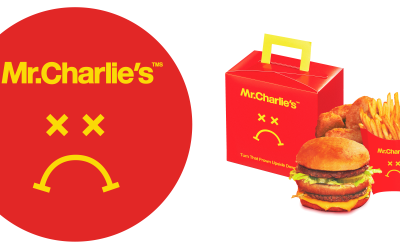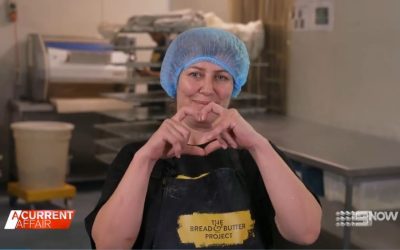The secret life of sourdough
The Bread & Butter Project is everyday proof that baking bread can literally change people’s lives. But what about the bread itself?
Take our signature sourdough, for example. What is sourdough bread? And why, after thousands of years, has Western civilisation apparently rediscovered it in 2020?
Sourdough’s simplicity does seem kind of magical. It’s just three ingredients: flour, water and salt – brought together to do their thing.
By contrast, check the nutrition information on a supermarket loaf one day and you’re likely to find a much longer list. There’ll probably be baker’s yeast for a start, plus sugar, soy flour, palm or canola oil, added gluten, corn starch, vegetable gum, emulsifiers…
Some of these ingredients extend the bread’s shelf life. But often, they’re just included to speed up the production process, or to make the bread more uniform and ensure it behaves predictably.
Time: the secret ingredient
As anyone who’s ever pulled a collapsed football or burned brick from the oven will tell you, you can’t expect that kind of consistency from sourdough. It appears to have a mind of its own. How it behaves seems to depend on the temperature, the humidity and sometimes, just the day.
And it won’t be rushed.
You can slow the process down. But trying to hurry sourdough never ends well. (See comment above about over-inflated footballs or under-risen burned bricks).
The jury’s still out on exactly why the world went crazy over sourdough in 2020. But maybe it has to do with the time and care that successful sourdough demands.
This may be part of a broader movement away from highly processed convenience foods. Plus, many of us found ourselves with unexpected time at home, and needed to take on a bit of a challenge to feel like we were doing something productive.
So, is sourdough healthier than other bread?
Serious food scientists are increasingly studying sourdough. And it looks as though this form of bread has some nutritional benefits compared to other types.
Obviously, if you have health issues or intolerances, you’ll need to speak to a health professional about them. But for the rest of us, there are excellent reasons to love sourdough beyond its tangy flavour, chewy texture and air holes waiting to be filled with delicious toppings.
Firstly, it’s that ‘flour, water, salt’ thing. That means less sugar, fewer additives and no added yeast or glutens. So it may appeal to people who worry about numbered chemicals in their food, or about how much sugar they’re putting into their bodies.
But the real kicker is the alchemy of the long fermentation process.
Slow food and fermentation
In case you haven’t succumbed to the sourdough craze yet, it’s made with a ‘sourdough starter’ or ‘mother’, rather than with yeast.
That’s because a starter contains wild yeasts, which come from the environment. As long as you keep feeding the starter, its yeasts will keep fermenting. So you can take some of the starter out and use it to make your bread rise.
Sourdough works because of the relationship between these wild yeasts and naturally occurring lactic acid bacteria (or lactobacilli) in the flour. These lactic acid bacteria give sourdough its sour taste, while also preventing unwanted microbes from growing in the starter.
The starter itself takes weeks to mature. Then the dough that contains the starter is allowed to mature further overnight – sometimes even for days. During this time, the lactic acid bacteria work on the flour in the dough mixture. As they do their thing, they seem to make the end product easier to digest, particularly for gluten-sensitive people.
This long fermentation process is thought to make it easier for our bodies to absorb the nutrients in sourdough.
There’s also growing evidence that fermented foods generally are great for gut health. Sourdough is believed to be one of these gut-friendly foods, containing prebiotics which help to feed our beneficial gut bacteria.
So yes, for those of us who’ll always need our daily bread – sourdough does look like a much better option.
Check you’re getting the real thing though
Be aware that not all sourdoughs are equal.
Bakers sometimes ‘sour’ yeasted breads by adding sourdough culture to their dough. There’s nothing wrong with this. But if you’re looking for simple, traditional sourdough, check the label or ask whether the bread contains baker’s yeast.
The Bread & Butter Project makes both yeasted breads and sourdoughs.
Buy your preferred type from any of over 200 stockists around Sydney.
From Passion to Pastry: The Bread & Butter Project Graduate Opens Adele’s Bakery in Wetherill Park
After months of planning and years of dreaming, Adele’s Bakery has officially opened its doors in Wetherill Park, marking a significant milestone for Tanya, former trainee at The Bread & Butter Project. Originally from Iraq, Tanya grew up with a love for cake...
Donate to The Bread & Butter Project this EOFY and help a refugee start a new life
As the 2024-25 financial year draws to a close, we are currently seeking donations to support The Bread & Butter Project’s ongoing mission to help refugees. Donations to our program will help shape the lives of refugees aspiring to become bakers, with our goal to...
100 graduates and counting…we couldn’t be prouder!
November 2024 marked a significant milestone for The Bread & Butter Project, with the graduation of our largest ever cohort of 26 graduates, including our 100th trainee. Held at the Surry Hills headquarters of our long-time corporate supporter, Canva, the...
Schools and universities get behind The Bread & Butter Project in 2024
This year, The Bread & Butter Project has been excited to partner with a wonderful team of schools, universities and sports clubs to help deliver quality meals and snacks, as well as a number of festive events. From sandwich breads and burger buns to on-the-go...
We’ve teamed up with Mr Charlie’s for vegan burgers!
The Bread & Butter Project is excited to announce its partnership with groundbreaking new fast-food chain, Mr Charlie’s. Launching its first Australian store in Sydney in late 2023, California-founded Mr Charlie’s takes on fast-food chains with its tasty...
A Current Affair visits The Bread & Butter Project
We’re extremely grateful to Channel 9’s A Current Affair for so eloquently telling the remarkable story of why we do what we do at The Bread & Butter Project, and the profound impact it has on the lives of so many refugees. Thank you to our wonderful team of...







